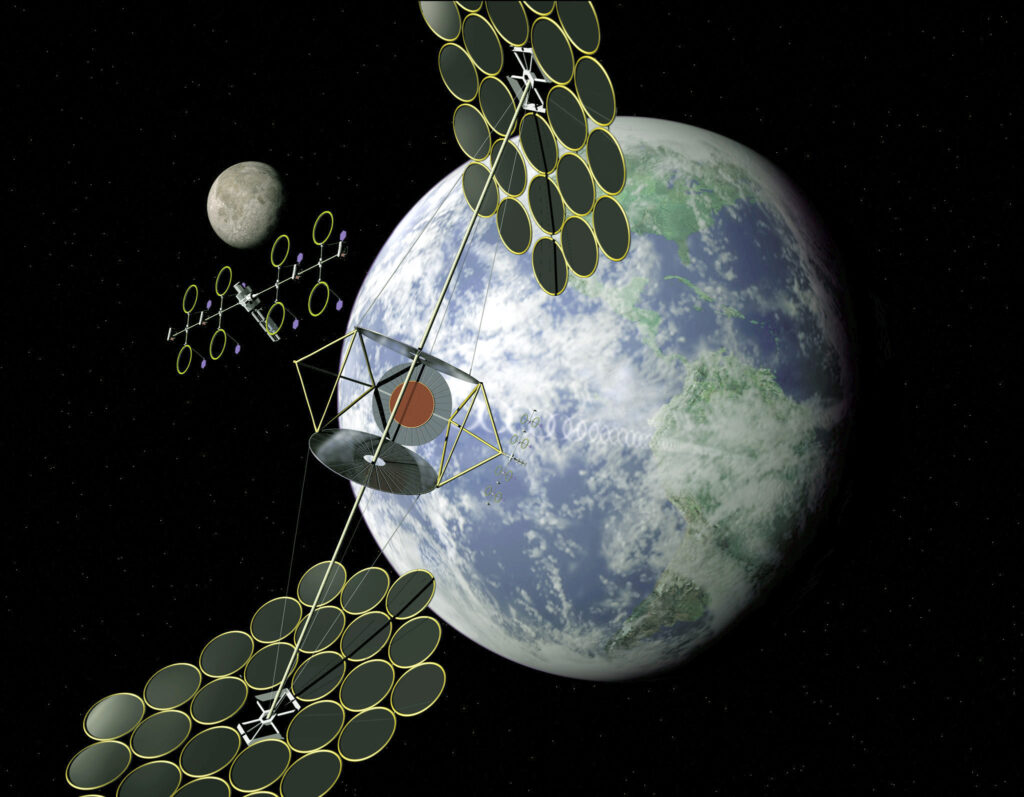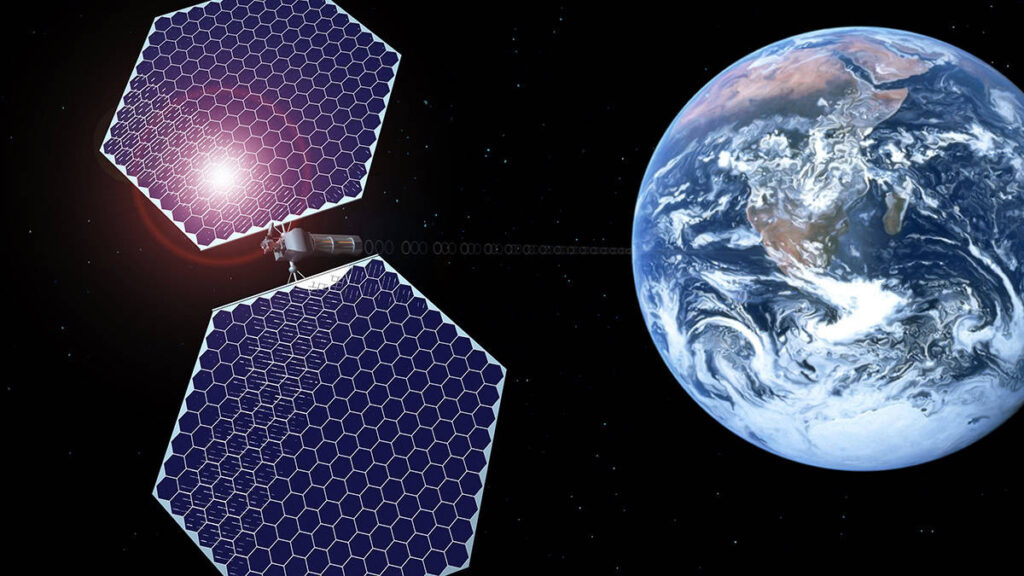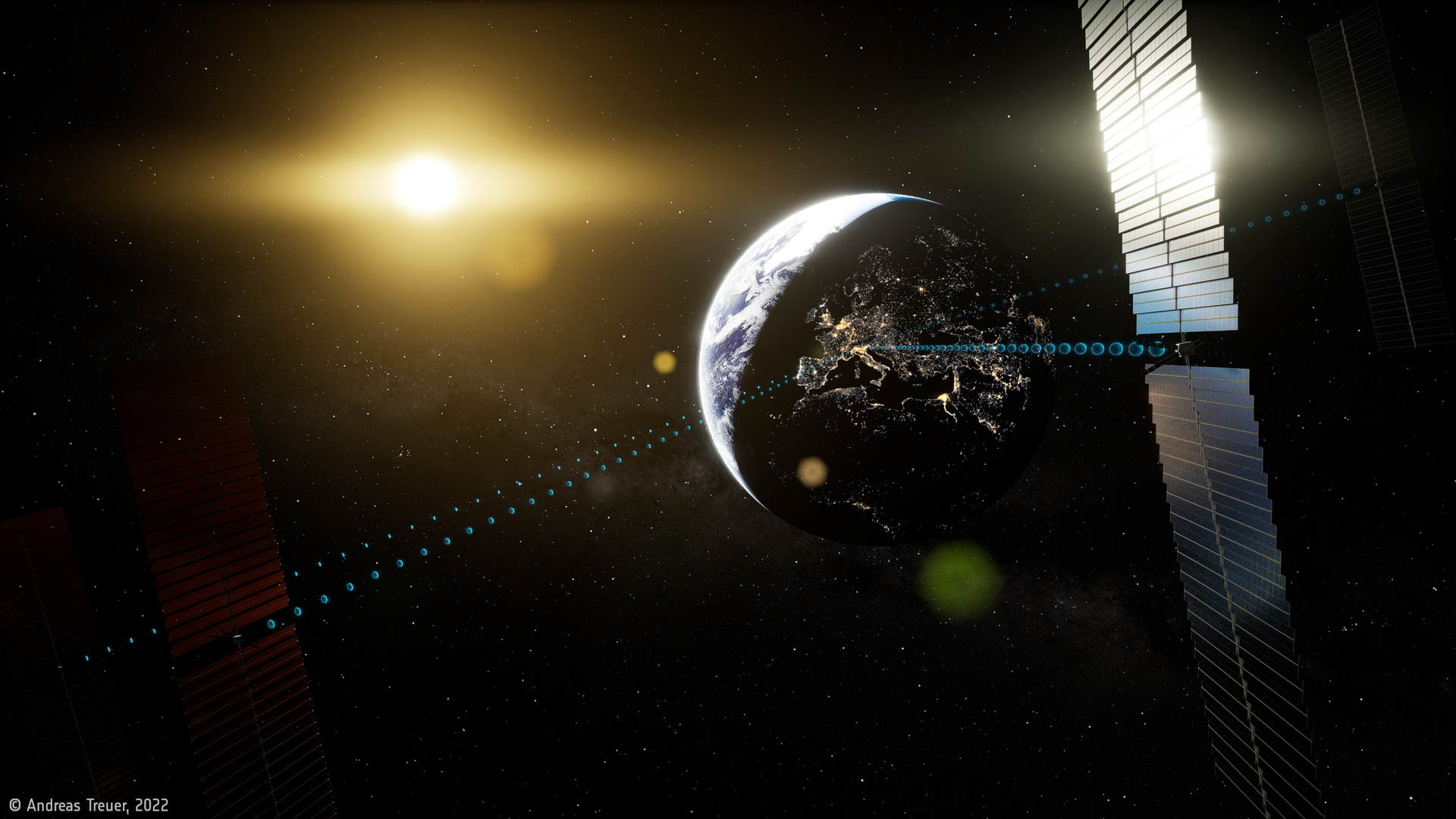Introduction

Imagine a world powered by limitless, clean energy. Not just when the sun is shining or the wind is blowing, but 24 hours a day, 7 days a week, in any weather. This isn’t a scene from a science fiction novel. It’s the bold promise of Space-Based Solar Power (SBSP), a revolutionary concept that could fundamentally change how we power our planet.
For decades, we’ve looked to the skies for communication, navigation, and weather data. Now, we’re on the cusp of looking to them for our very energy. What if we could capture the sun’s immense power directly in space, where it’s always available, and send it down to Earth? This complete guide will demystify the technology, explore its incredible potential, and tackle the very real challenges that stand between this visionary idea and our everyday reality.
What Exactly Is Space-Based Solar Power?

In its simplest terms, Space-Based Solar Power (SBSP) is the concept of collecting solar energy in outer space and distributing it to Earth.
Think of it like this: A traditional solar farm is at the mercy of the night, clouds, and seasons. A space-based solar power system, however, is like building the ultimate solar panel—one that sits in permanent sunlight, 22,000 miles above the Earth. It collects the sun’s energy unimpeded, converts it into a transmissible form, and beams it wirelessly to a receiving station on the ground, where it’s fed directly into our electrical grid.
The core idea isn’t new; it was first proposed by Dr. Peter Glaser in 1968. But for a long time, it remained a futuristic dream, held back by the colossal costs and technological hurdles. Today, with the urgent need for clean energy and the dramatic reduction in launch costs led by companies like SpaceX, SBSP is being seriously reconsidered by governments and private companies alike. It’s no longer a question of if it’s possible, but when it will become a reality.
Why Go All the Way to Space? The Unbeatable Benefits
Why go through the immense trouble of building a power plant in space when we can just put more panels on our roofs? The advantages are profound and address the core limitations of terrestrial renewables.
- 24/7 Availability, Rain or Shine: This is the single biggest benefit. In Geostationary Orbit (GEO), a satellite experiences no night, no clouds, and no atmospheric filtering. It can collect sunlight over 99% of the time, compared to the 15-30% capacity factor of a typical ground-based solar farm. This provides what the energy grid desperately needs: baseload power—a constant, reliable stream of energy.
- Vastly Higher Energy Density: Sunlight traveling through Earth’s atmosphere loses a significant portion of its energy. In the vacuum of space, solar irradiance is far more intense and consistent. A solar panel in space can generate up to eight times more power than an identical panel on the ground over a year.
- Global Energy Distribution: A network of SBSP satellites could beam energy to virtually any location on the globe that has a receiving station. This is a game-changer for providing power to remote islands, disaster-stricken areas where the grid is destroyed, or developing nations without extensive energy infrastructure. Energy could become a truly global commodity.
- A Truly Clean Energy Source: The operation of an SBSP system produces zero greenhouse gas emissions. While there are environmental costs associated with its manufacturing and launch, its lifelong carbon footprint would be minimal compared to fossil fuels, offering a path to deep decarbonization of our energy systems.
How on Earth (and in Space) Does It Work?
The engineering behind SBSP is as elegant as it is complex. Let’s break down the process step-by-step.
Step 1: Collection – The Orbital Power Plant
The system begins with a massive satellite, often called a solar power satellite, positioned in geostationary orbit. This isn’t a small probe; we’re talking about structures that could be over a kilometer across—sometimes compared to the size of a small city. This satellite is covered with vast arrays of lightweight, highly efficient solar panels or uses giant, lightweight mirrors to concentrate sunlight onto a smaller collector.
Step 2: Conversion – From Sunlight to Microwaves
The collected solar energy is in the form of direct current (DC) electricity. This DC power can’t simply be “beamed” down. It must first be converted into a transmissible form of energy. The most studied and likely method is microwave power transmission.
The satellite uses a device called a magnetron or a solid-state amplifier to convert the DC electricity into low-energy, long-wavelength microwaves—the same kind used in your microwave oven, but far less concentrated. An antenna, or “spacetenna,” then focuses this microwave beam precisely towards Earth.
Why microwaves? They can efficiently penetrate clouds, rain, and dust with minimal energy loss, ensuring reliable delivery in almost any weather condition. Lasers are also being researched, but they are more susceptible to atmospheric interference.
Step 3: Reception – Catching the Beam on Earth
The transmitted microwave beam is aimed at a dedicated ground station called a rectenna—a portmanteau of rectifying antenna. This is a vast but simple network of antennas spread over a large area (imagine several hundred football fields) designed to capture the incoming microwaves and convert them back into usable DC electricity. This is then converted to AC and fed directly into the power grid.
Safety Note: This is the part that often raises eyebrows. Is it safe to have a microwave beam raining down from the sky? The answer is a resounding yes, by design. The beam’s intensity would be carefully controlled to be non-lethal. It would be spread over a large area, making its power density at ground level no greater than the sunlight you feel on a sunny day. Birds or aircraft flying through the beam would experience minor warming, but no harm. The system would also include automatic shut-off features if the beam were ever to drift off-target.
The Immense Hurdles: Why Aren’t We Doing This Already?
For all its promise, the path to SBSP is littered with monumental challenges. Acknowledging them is crucial to understanding the scale of the endeavor.
- The Astronomical Cost: This is the biggest barrier. Launching the thousands of tons of material required for a single satellite into space is phenomenally expensive. While the cost per kilogram to orbit has plummeted thanks to reusable rockets, it’s still a multi-hundred-billion-dollar undertaking for a full-scale system.
- A Mind-Boggling Engineering Feat: Assembling a structure the size of a kilometer-scale satellite in orbit is an unprecedented challenge. It would require major advances in robotics, in-orbit manufacturing, and autonomous assembly. We are talking about the largest structures ever built by humanity, constructed in the harsh environment of space.
- The Efficiency Question: Every step of the process—conversion from DC to microwaves, transmission through the atmosphere, and rectification back to DC—incurs energy losses. While the initial solar collection is far more efficient, the end-to-end efficiency of the system must be high enough to make the entire venture economically viable.
- Safety, Environment, and Politics: Public perception of the “power beam” must be managed through transparency and rigorous safety testing. There are also concerns about the potential impact of powerful microwave transmissions on astronomy and the local ecosystem around the rectenna. Furthermore, the technology raises novel questions about international regulation, space law, and energy security.
The Current Players: Who’s Turning Science Fiction into Reality?

The SBSP landscape is heating up, moving from PowerPoint slides to tangible experiments and government-backed initiatives.
- Europe: The European Space Agency (ESA) has launched its SOLARIS initiative. This is a comprehensive research and development program designed to mature the key technologies of SBSP, assessing the feasibility of a full-scale program by 2025. It’s a clear signal that Europe sees SBSP as a serious component of its future energy security.
- The United Kingdom: The UK government has committed significant funding, with a bold vision to have an operational SBSP system by the 2030s. They are actively funding studies and technology development projects, positioning the UK as a potential global leader in this new energy sector.
- The United States: Research is thriving across multiple fronts. In a landmark moment in 2023, a team at the California Institute of Technology (Caltech) announced the first successful experiment to beam detectable solar power from space to Earth using their MAPLE instrument. This was a critical, small-scale proof-of-concept. Meanwhile, the U.S. Air Force Research Laboratory and NASA continue to investigate the technology.
- Japan (JAXA): Japan has been a long-time pioneer in SBSP research, with a particular focus on the precision required for microwave power transmission. JAXA has conducted some of the world’s most advanced ground and aerial demonstrations and has a roadmap for a commercial system.
- Private Companies: A new wave of startups like Virtus Solis is entering the arena, aiming to develop commercial SBSP systems. These companies often propose more modular, scalable designs to help overcome the massive upfront costs.
The Future is Bright (and Beaming from Above)

So, what is the realistic future of Space-Based Solar Power? It won’t happen overnight. The next decade will likely be dominated by crucial technology demonstrations, small-scale experiments in Low Earth Orbit, and continued work on driving down costs.
The true game-changer will be the maturation of in-orbit manufacturing and assembly. If we can learn to build these massive structures using materials mined from the Moon or asteroids, we can avoid the cost and difficulty of launching everything from Earth.
SBSP is not envisioned as a replacement for wind, terrestrial solar, or nuclear power. Instead, it is the missing piece of the puzzle—the source of constant, reliable, and immense clean energy that can work in harmony with Earth-based renewables to create a fully decarbonized, resilient global energy grid.
Conclusion: A Vision Worth Pursuing
The journey to harness the sun’s power from space is one of the most ambitious engineering challenges humanity has ever contemplated. It is a marathon, not a sprint, filled with technical, financial, and political hurdles. Yet, the potential reward is nothing short of transformational: a world with abundant, clean, and globally accessible energy.
It’s a vision that pushes the boundaries of human ingenuity, a testament to our enduring drive to look beyond our planet to solve our greatest challenges at home. The dream of a power plant in the sky is no longer just a dream—it’s a project in the making, and its success could light up our future in ways we are only beginning to imagine.



0 Comments